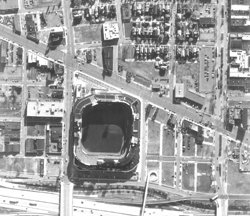The University Record, January 10, 2000 By Joanne Nesbit
News and Information Services

Detroit’s Greater Corktown and Briggs neighborhoods are the focus of a five-day planning and design workshop held through Jan. 11, hosted by the A. Alfred Taubman College of Architecture and Urban Planning. The special workshop, called a design charrette, is bringing together some of Detroit’s leading design professionals, as well as top urban designers from across the nation and graduate students from several universities.
What is a design charrette? The short answer is that it is an illustrated brainstorm. The long answer is a five-day, intensive design and planning workshop in which competing teams, led by local and out-of-town design professionals, develop design proposals and present them at a public review. It is meant to advance creative but feasible solutions to social, civic and environmental challenges. Although it advances theory and teaching, the charrette is not a hypothetical or pedagogic exercise, but rather an attempt at civic engagement and community service. It can galvanize a neighborhood, jump-start real projects or generate a vision for a neighborhood.
Paul Bernard, director of the Detroit Planning and Development Department, suggested the study area, and local community groups embraced the exercise in the hope that it may help them clarify a vision and kick-start investment and development in the area. The charrette was offered pro bono as a contribution to the revitalization of Detroit as the city defines itself for the next century.
The Greater Corktown and Briggs neighborhoods are experiencing transition with the departure of the Tigers baseball team to Comerica Park. Both hold great potential for new growth opportunities.
Although organized by Taubman College, several other schools at the U-M as well as Wayne State and Michigan State universities and the University of Miami (Florida) are contributing students and/or faculty. Additional sponsors include Detroit Edison, the City of Detroit Office of the Mayor, the City of Detroit Department of Planning and Development and the Teamsters Joint Council #43. Participating organizations include the Corktown Citizen’s District Council, the Corktown Consumer Housing Cooperative, the Greater Corktown Economic Development Corporation and the Greening of Detroit.
Elizabeth Plater-Zyberk, principal of Duany Plater-Zyberk of Miami and co-founder of the Congress for the New Urbanism, and Alex Krieger, chair of Harvard University’s Department of Urban Planning and Design, are among two of a number of designers of international acclaim who have led design teams at the charrette.
The charrette will culminate Jan. 11 in a slide presentation of the results of the work done by five teams and remarks by Detroit Mayor Dennis Archer. The free, public program opens with a reception at 4:30 p.m. at the Teamsters Welfare Fund Building, 2700 Trumbull St., Detroit.
U-M participants include Yvette Amstelveen, visiting scholar/artist-in-residence, School of Art and Design; Charles Bright, lecturer in history; James Chaffers, professor of architecture; Donna Erickson, chair of landscape architecture, School of Natural Resources and Environment; Aseem Inam, assistant professor of urban planning; Douglas Kelbaugh, dean and professor of architecture and urban planning, Taubman College; June Komisar, lecturer in technical communication, College of Engineering; David Scobey, associate professor of architecture; Laura Swartzbaugh, assistant professor of urban planning; Blake Williams, adjunct lecturer in architecture; Andrew Zago, adjunct lecturer in architecture; and principal, Zago Architecture, Detroit.

